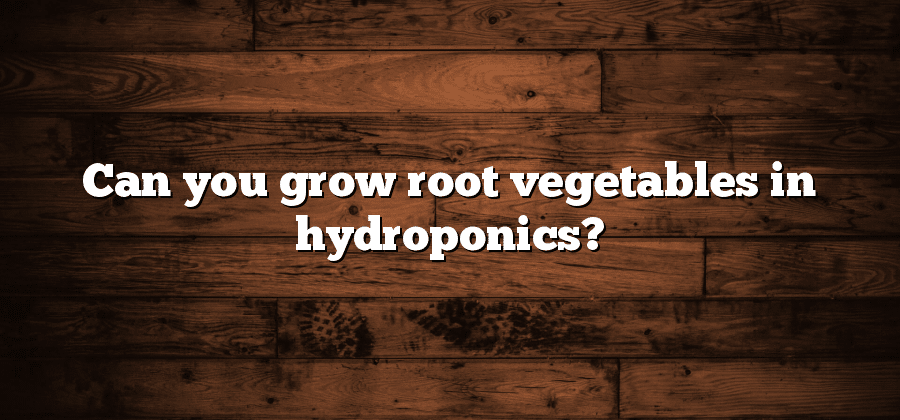Benefits of Growing Root Vegetables Hydroponically
Hydroponic systems have revolutionized the way we grow plants, and root vegetables are no exception. Growing root vegetables hydroponically comes with an array of benefits that make it an attractive option for home gardeners and commercial farmers alike.
One of the main advantages of growing root vegetables hydroponically is the ability to control the growing environment. With hydroponics, you can fine-tune factors such as temperature, humidity, light intensity, and nutrient levels, ensuring that your plants receive optimal conditions for growth. This level of control leads to faster and more consistent growth, resulting in higher yields of healthy and nutrient-rich root vegetables. Additionally, hydroponic systems can be set up in any space, making it possible to grow root vegetables even in urban areas where traditional gardening space is limited.
Ideal Root Vegetables for Hydroponic Systems
When it comes to selecting root vegetables for hydroponic systems, there are a few that stand out as ideal choices. These vegetables thrive in a soil-less environment and can be grown successfully using hydroponic techniques. One of the top choices is carrots. Carrots grown hydroponically tend to be sweeter and more flavorful than their soil-grown counterparts. They also grow faster and have a more uniform shape, making them visually appealing. Another great root vegetable for hydroponics is radishes. Radishes are known for their quick growth, which makes them a popular choice for hydroponic systems. They can be harvested in as little as three weeks and come in a variety of shapes, sizes, and colors.
Beets are also well-suited for hydroponic cultivation. They have a relatively short growing period and can be harvested in just eight to ten weeks. Hydroponically grown beets are known for their vibrant colors, sweet flavor, and tender texture. Additionally, turnips make a great addition to a hydroponic garden. They have a compact root structure, which makes them ideal for vertical growing systems. Plus, turnips grown hydroponically tend to be sweeter and less fibrous than those grown in soil. With their earthy flavor and versatility in cooking, turnips are a favorite among many hydroponic enthusiasts.
Choosing the Right Hydroponic System for Root Vegetables
When it comes to growing root vegetables hydroponically, choosing the right hydroponic system is crucial for their successful cultivation. There are various types of hydroponic systems available, each with its own advantages and limitations. It is important to consider factors such as the space available, budget, and specific requirements of the root vegetables being grown.
One of the most commonly used hydroponic systems for root vegetables is the nutrient film technique (NFT). This system involves a shallow, sloping channel where a thin film of nutrient-rich water flows continuously over the roots of the plants. NFT systems are ideal for crops with shallow roots, such as lettuce and spinach, but can also be used for certain root vegetables like radishes and turnips. They are highly efficient in terms of water usage and nutrient delivery and are relatively easy to set up and maintain. However, it is important to ensure that the roots of the plants do not dry out, as this can lead to stunted growth or wilting.
Understanding Nutrient Requirements for Root Vegetables
Root vegetables grown hydroponically have specific nutrient requirements that need to be carefully managed in order to ensure optimum growth and yield. These plants rely heavily on a balanced supply of essential nutrients, including nitrogen, phosphorus, and potassium, to support their root development and overall health.
Nitrogen is an important element for root vegetable growth, as it plays a crucial role in the production of proteins and enzymes that are essential for various metabolic processes. However, excessive nitrogen can result in lush foliage growth at the expense of root development. Therefore, it is important to provide a moderate amount of nitrogen to root vegetables, ensuring that their nutrient needs are met without promoting excessive vegetative growth.
Phosphorus is another key nutrient for root vegetables, as it aids in the formation of strong and healthy roots. It also supports the transfer and storage of energy within the plants, contributing to their overall vitality. Potassium, on the other hand, helps regulate water movement within the plant and plays a vital role in root cell division and the transport of sugars. Balancing the supply of phosphorus and potassium is crucial for promoting robust root growth in hydroponic root vegetable systems.
Best Techniques for Starting Root Vegetables from Seeds
Starting root vegetables from seeds can be an efficient and rewarding way to grow your own produce. However, it is important to follow the best techniques to ensure successful germination and healthy growth.
First and foremost, choose high-quality seeds that are specifically labeled for root vegetables. Opt for reputable seed suppliers that offer a wide variety of root vegetable seeds to ensure the best chances of success. Additionally, consider using heirloom or organic seeds for an even more sustainable and flavorful harvest. It is also crucial to start the seeds indoors in a controlled environment before transplanting them to your hydroponic system. This allows for better control over temperature, light, and moisture levels, which are essential for successful germination.






